6" jointer.
Up until about a six months ago, woodworking incredibly frustrated me. I would design a shelf or box or whatever, buy plywood and/or framing lumber, measure everything twice, cut once, and at the end of the day I was always disappointed that no matter how careful I was, either none of the mitres would align, or my rectangle was longer on one side, or basically it looked like something a 10-year old put together in arts and crafts class. They say it is a poor craftsman that blames his tools, and while I was using cheap tools from Canadian Tire, there really wasn’t anything wrong with them.
Then I bought my planer. I had a large stack of rough sawn barn board. My shop walls had already been clad with the stuff but there was a few feet remaining. I bought a Canadian Tire model and after putting two boards through it, it stopped feeding. I tried cleaning the rollers but it only helped temporarily. I was having none of it. I returned the planer the next day and promised myself that since I was a grown up now I needed to stop buying cheap tools.
The next day I bought a Dewalt DW735 (the beast) and it changed my life. I wasn’t making things that looked that they were made from cheap framing lumber anymore. They had sharp edges and smooth surfaces. Stains and finishes brought out the texture of the wood instead of hiding it. A few months later my planer stopped feeding like my first one did. I kept cleaning the rollers with mineral spirits and it would help a bit, and briefly. Every website and video I looked at implied that my knives were dull. I completely dismissed it, because I hadn’t had this thing THAT long, and I hadn’t run THAT much wood through it. I was looking up warranty information and getting ready to write a harshly-worded letter when I decided, what the hell, I’ll try flipping the knives over. It ran like new.
Especially with the CNC and wanting to make a farm sign I was more frequently trying to glue up panels of wood edge-to-edge, and the odd time I’d get lucky, but usually I was very disappointed. Maybe my table saw wasn’t cutting straight enough, or I was measuring incorrectly, but I couldn’t help notice that I had never actually seen a truly straight piece of wood. I saw people use jointers on Youtube and frankly it looked like witchcraft. A device that took imperfect wood and made it perfect? Not using 12 clamps and a stack of call blocks to join two pieces of wood together (and fail)?
Jointers were too expensive, and even a bunch of the woodworking guys on Youtube didn’t have them, so I certainly didn’t NEED one. I follow the local farm auctions and I found a 6" planer. I got it for just over $100. It was at least 20 years old, heavy, awkward, and I had to disassemble it to fit it in my car. Anyways I got it home, put it back together, and other than the motor being a little grumpy about starting occasionally, it worked. Sure enough, like magic, I run a warped or cupped board over it a few times, and it comes out perfect. I even took scraps from my waste bin, cut them to similar widths, straightened them with the jointer, glued them up, into a big block, and ran through the planer to make perfect looking cutting-board shaped blocks.
Not sure what the moral of this story is but I guess you could say that while a skilled craftsman can make nice pieces with a hand saw, chisel and hand plane; my jointer and planer make me look far more skilled than I really am.






